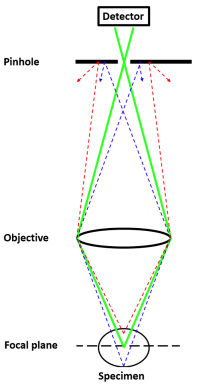The Cell Imaging Center houses two types of confocal microscopes: the Olympus FV1000 and the Zeiss LSM700.
Main advantage
A confocal microscope is a type of fluorescence microscope that enables the acquisition of high-resolution images without interference from out-of-focus light. Confocal microscopes obtain images from single focal planes within a sample, which can be optically sectioned by acquiring images serially across the z-axis. This process, known as optical sectioning, renders possible the three-dimensional reconstruction of a specimen.
How does it work?
Use of lasers
In confocal microscopy, laser light is focused into a very small spot and is scanned across the specimen to reconstitute a 2D image. This is in contrast to wide-field microscopes in which the entire specimen is illuminated at once by a mercury arc lamp. As opposed to other light sources, laser light is monochromatic, coherent and collimated, meaning that photons have the same wavelength, the same phase and propagate into the same direction. It is these physical properties that enable focusing laser light into a diffraction-limited spot.

Use of a pinhole
When a light source is used to excite a fluorescent specimen, not only does it excite fluorophores from the focal plane (the plane to be imaged) but also fluorescent molecules located above and below the focal plane. This out-of-focus fluorescence is collected by the lens and measured by the detector. As a result, images acquired by wide-field microscopes may appear blurry. Out-of-focus light is the reason why wide-field microscopy is usually limited to the study of thin specimens.
The key part of a confocal microscope is the pinhole placed in front of the detector at the confocal plane of the objective. Thanks to this pinhole, only light emitted from the small focal spot is detected. Out-of-focus light (red and blue dash lines in diagram) is eliminated because it follows a different light path and thus does not go through the pinhole.
Detector
In laser-scanning confocal microscopy, a small excitation spot is scanned across the specimen and emission is simultaneously detected, spot after spot. Thus, in contrast to wide-field microscopes that project the fluorescent image of the specimen onto a camera chip, confocal microscopes detect and quantify each spot one at a time by a photosensitive detector, which is typically a photomultiplier tube (PMT). Each spot will be visualized as a pixel in the final image.